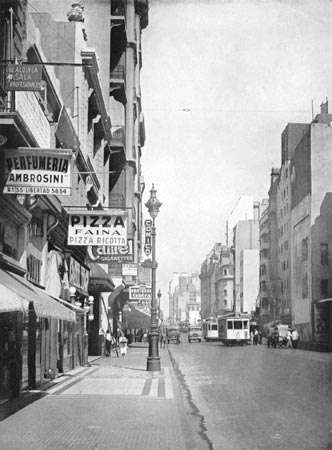Archive
Buenos Aires 1936. Visión fotográfica
- Photobook
- Buenos Aires 1936. Visión fotográfica
Word Count: 6
- Buenos Aires 1936: Cuarto centenario de su fundación. Visión fotográfica
- Horacio Coppola
- 1936
Hardcover book of 230 pages and 207 black and white photographies
Av. Corrientes and Av.9 de Julio, Buenos Aires (depicted place).
- Spanish
32 x 23 cm.
- Buenos Aires (AR)
For the commemoration of the 400th anniversary of the foundation of Buenos Aires, photographer Horacio Coppola was commissioned by its municipality to portray the city.
Word Count: 25

Horacio Coppola, Buenos Aires 1936: Cuarto centenario de su fundación. Visión fotográfica. Municipalidad de la Ciudad de Buenos Aires, 1936. 
Horacio Coppola, "La Avenida Corrientes, recientemente ensanchada sobre su lado sur. Vista desde la cuadra del 1200 hacia el oeste", in Buenos Aires 1936: Cuarto centenario de su fundación. Visión fotográfica. Municipalidad de la Ciudad de Buenos Aires, 1936 (via Wikimedia Commons). 
Horacio Coppola, "Nocturno. Calle Corrientes desde Reconquista hasta Plaza de la República (centro)", in Buenos Aires 1936: Cuarto centenario de su fundación. Visión fotográfica. Municipalidad de la Ciudad de Buenos Aires, 1936 (via Wikimedia Commons). 
Horacio Coppola, "Plaza de la República. Fiesta de la Bandera (Centro)", in Buenos Aires 1936: Cuarto centenario de su fundación. Visión fotográfica. Municipalidad de la Ciudad de Buenos Aires, 1936. 
Horacio Coppola, "Bar Madrid sobre la Avenida de Mayo", in Buenos Aires 1936: Cuarto centenario de su fundación. Visión fotográfica. Municipalidad de la Ciudad de Buenos Aires, 1936 (via Wikimedia Commons). 
Horacio Coppola, "Liquidación en una casa de trajes, Buenos Aires, esquina de Bartolomé Mitre y Maipú en 1936", in Buenos Aires 1936: Cuarto centenario de su fundación. Visión fotográfica. Municipalidad de la Ciudad de Buenos Aires, 1936 (via Wikimedia Commons). Fara, Catalina. “La construcción de un imaginario de ciudad moderna a través de un fotolibro: Buenos Aires 1936. Visión fotográfica de Horacio Coppola.” Latin American and Latinx Visual Culture, vol. 2, no. 1, January 2020, pp. 92–100, doi: https://doi.org/10.1525/lavc.2020.210008. Accessed 23 April 2021.
Príamo, Luis. “Comentario sobre Buenos Aires nocturno.” Museo Nacional de Bellas Artes, www.bellasartes.gob.ar/coleccion/obra/9909/. Accessed 4 March 2021.
Word Count: 64
Coppola, Horacio, et al. Buenos Aires 1936: Cuarto centenario de su fundación. Visión fotográfica. Municipalidad de Buenos Aires, 1936.
Coppola, Horacio. Buenos Aires 1936: Cuarto centenario de su fundación. Visión fotográfica. Municipalidad de Buenos Aires, 1937.
Word Count: 38
My deepest thanks to Catalina Fara for sharing her texts.
Word Count: 10
- Obelisk
Av. Corrientes and Calle Paraná, Buenos Aires; Av. Corrientes 1200, Buenos Aires; Bar Madrid, Av. de Mayo 701, Buenos Aires; Calle Bartolomé Mitre y Maipú, Buenos Aires; Edificio COMEGA, Av. Corrientes 222, Buenos Aires.
- Buenos Aires
- Laura Karp Lugo. "Buenos Aires 1936. Visión fotográfica." METROMOD Archive, 2021, https://archive.metromod.net/viewer.p/69/2950/object/5140-11020675, last modified: 09-09-2021.
-
Horacio CoppolaFilmmakerPhotographerBuenos Aires
Born in Buenos Aires, Horacio Coppola is one of the photographers who represent modern photography in Argentina.
Word Count: 17
Grete SternPhotographerBuenos AiresGrete Stern is one of the photographers that represent modern photography in Argentina. Her house in Ramos Mejía was a meeting place for local and foreign artists and intellectuals.
Word Count: 30
ObeliscoMonumentBuildingBuenos AiresThe Obelisk is undoubtedly the most well-known emblem of the city; it was built by architect Alberto Prebisch in 1936 for the 400th anniversary of the founding of Buenos Aires.
Word Count: 29